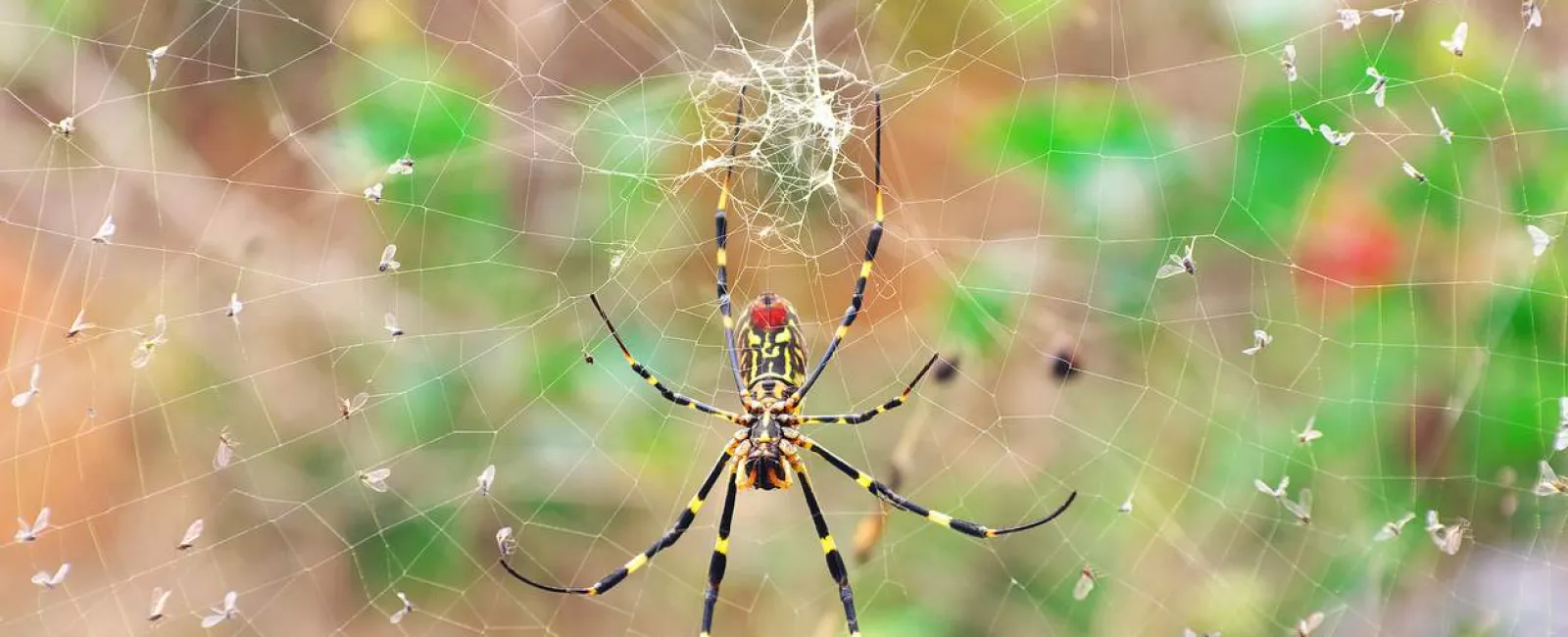If you're a resident of Georgia, you've likely noticed a new creepy crawling spider making its way into your yard and home the past few years. Even if you live outside of the Peach State, there's a good chance you may soon encounter these brightly colored eight-legged freaks too.
Joro spiders look like an arachnid that will give you superpowers but there's no need to worry, this invasive species is more of a nuisance than anything. Learn more about how to identify a Joro spider, where you might encounter them, and what to do if your home becomes the site of an infestation. To learn to identify whether it has become a problematic infestation, read our article When Do Spider Infestations Become a Problem?
Where are Joro Spiders Commonly Found?
As an invasive species from southeast Asia, these spiders are attracted to warm and humid climates and are commonly found in trees and bushes. Experts believe Joro spiders traveled to the U.S. on cargo ships, growing in mass numbers when they landed in Georgia. Now that they've been around for a while, the chance of Joro spiders hitching a ride on a car or luggage and expanding across the country is high.
Between their high metabolism and high heart rate, these spiders have a good chance of surviving off brief freezes that kill off many of their cousins. Though initially spotted in warm, humid southeast states, Joro spiders are likely to make it to your neighborhood this summer if they haven't already done so.
Will Joro Spiders Spread to Other States?
Reports from the University of Georgia claim Joro spiders were first spotted in the area between 2013 and 2014 with confirmed sightings in 2015. Since then, they've made their way up the eastern seaboard, making their presence known in Tennessee, North Carolina, and South Carolina.
Experts at ballooning, a practice in which Joro spiders spin a web to catch the air current, allowing them to fly for 50-100 miles before latching onto a tree, these active travelers are expected to continue moving across the U.S. and spread into northern states.
How do I Identify a Joro Spider?
Size - These arachnids are known to have a large abdomen and even longer legs. They typically measure between ¼ of an inch to an inch long and can fit comfortably in the palm of your hand.
Color - Female Joro spiders boast brightly colored bodies with deep blue and yellow bands on their legs. In addition, their abdomens feature red, yellow, and black asymmetrical patterns. Their male counterparts are light brown with dark brown stripes.
Webs - Similar to other spiders, female Joro spiders have the ability to weave webs. Their webs can be as large as 10 feet wide and are usually suspended between two objects. Male joro spiders do not spin webs but can be found near them.
What do Joro Spiders Eat?
Much like typical orb-weaver spiders, Joro spiders eat a variety of small insects including mosquitoes, biting flies, and stink bugs. The protein and nutrients from insects are vital to the Joros diet.
In turn, these eight-legged creatures are a new food source for birds. As Joros are new to the ecosystem of the U.S., researchers are unsure of how they will fit into the cycle but it is believed that they don't pose a threat to the ecosystem.
Are Joro Spiders Dangerous?
Despite being venomous, joro spiders are not dangerous to humans or pets. These pests won't bite unless cornered and even if you are unlucky enough to experience a bite, their fangs are typically not large enough to break human skin. Unless you're allergic to the venom, there's no need to be afraid of Joro spiders. In fact, they're more afraid of you than you are of them and will run away if you disturb their web.
How Do You Get Rid of Joro Spiders?
The easiest way to eliminate Joro spiders is to simply squish them. Whether you want to pull their web down with a broom or squish them under your shoe is up to you. While it may not be realistic to rid your entire property of spiders, taking down their webs will encourage these creepy crawlies to find somewhere else to call home.
General spider prevention tips include:
- Keeping a tidy home and regularly emptying the trash
- Storing food in sealed containers and sweeping up any crumbs
- Sealing cracks and potential entry points around your home
If you find yourself overwhelmed with Joro spiders repopulating quicker than you can smash them, it's time to give Greenix Pest Control a call. Our service experts have spent the last decade perfecting a responsible pest control process to protect you, your home, and your animals with the highest quality solutions and treatment plans specific to your needs.
Request a free quote today and send Joro spiders jetting off to their next destination.


